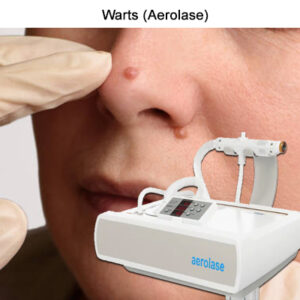
-
Quickview
Warts
$450.00 Select options This product has multiple variants. The options may be chosen on the product page
Unlocking the Potential: Aerolase Laser for Wart Removal
Aerolase laser treatment is an innovative solution in dermatology, specifically targeting and eliminating warts. Understanding this groundbreaking approach involves:
Delving into the nature of warts.
Exploring the technology behind Aerolase.
Uncovering its advantages.
Preparing for treatment and post-care instructions.
Acknowledging potential risks.
Warts, a common skin condition, emerge due to human papillomavirus (HPV) infections, causing non-cancerous growths on the skin’s surface. These growths appear as small, rough lumps, often resembling a cauliflower or solid blister.
Warts have the potential to appear across the body, displaying differences in size, shape, and appearance influenced by the specific strain of HPV responsible for their development. Several types exist, including common warts, plantar warts on the feet, flat warts, and genital warts.
Aerolase laser technology introduces a targeted method for wart removal. This advanced treatment involves precisely applying laser energy to penetrate the skin, targeting the blood vessels supplying the wart. The energy heats and damages these vessels, ultimately eliminating the wart. Unlike conventional methods, Aerolase’s focused energy minimizes damage to surrounding healthy skin, offering an efficient and less invasive approach.
The advantages of Aerolase for wart removal are multifaceted.
Its accuracy in pinpointing the wart reduces the likelihood of scarring or harm to the neighbouring skin—an often prevalent concern associated with alternative treatments. Furthermore, the effectiveness of Aerolase is often comparable to or surpasses traditional methods, leading to quicker recovery times and reduced chances of recurrence.
Before undergoing Aerolase treatment, patients are advised on pre-treatment guidelines and undergo a consultation with a qualified practitioner. This consultation involves discussing medical history, current medications, and potential expectations from the treatment. Understanding what to expect during the procedure is essential; patients might experience mild discomfort or a warm sensation during the laser application, but the process is relatively quick and tolerable.
Following Aerolase treatment for wart removal, adherence to specific aftercare instructions is crucial. Patients are often advised to keep the treated area clean and dry, avoiding picking or scratching the treated site to prevent infection or scarring. Typically, the recovery timeline varies among individuals, but gradual improvements and complete healing occur over a few weeks, with visible reduction or elimination of the wart.
While Aerolase treatment for warts is generally safe, potential risks and considerations exist. Certain individuals may encounter short-term side effects such as temporary redness, swelling, or mild discomfort at the treated site. However, these effects typically subside within a few days to a week. Ideal candidates for Aerolase wart treatment are those seeking an efficient, minimally invasive approach and with realistic expectations regarding the treatment outcomes.
In conclusion, Aerolase laser treatment presents an effective and advanced method for wart removal. Its precision, effectiveness, and minimal invasiveness make it an appealing option for individuals aiming to eliminate warts while minimizing damage to healthy skin.
Grasping the procedure, its advantages, and possible considerations enables individuals to make knowledgeable choices regarding opting for Aerolase treatment to eliminate warts.
Q&A
What causes warts?
The presence of non-cancerous growths on the skin’s surface is attributed to an infection caused by the human papillomavirus (HPV), leading to the formation of warts.
How does Aerolase laser technology target and eliminate warts?
Aerolase uses focused laser energy to penetrate the skin, targeting the blood vessels supplying the wart. This energy damages the vessels, leading to the elimination of the wart.
What types of warts can be treated with Aerolase?
Aerolase laser treatment can address various types of warts, including common, plantar, flat, and genital warts.
What are the advantages of using Aerolase for wart removal?
Aerolase offers precise targeting, reducing the risk of scarring or damage to surrounding skin. It’s efficient, minimally invasive, and often results in quicker recovery times.
What should patients expect during an Aerolase treatment for wart removal?
Patients may experience mild discomfort or warmth during the laser application, but the procedure is generally quick and tolerable.
How long does the recovery process take after Aerolase treatment?
The recovery timeline varies among individuals, but gradual improvements and complete healing typically occur over a few weeks after the treatment.
Are there any potential side effects associated with Aerolase treatment for warts?
Although uncommon, transient side effects may encompass redness, swelling, or slight discomfort at the treated site, typically resolving within a few days to a week and usually within days to a week.
Who is an ideal candidate for Aerolase wart treatment?
Ideal candidates seek efficient and minimally invasive treatment for warts while maintaining realistic expectations about treatment outcomes.
How does Aerolase compare to traditional wart removal methods?
Aerolase is often comparable to or more effective than traditional methods, offering quicker recovery times and reduced chances of scarring.
What pre-treatment guidelines should patients follow before Aerolase wart removal?
Patients should follow pre-treatment guidelines and undergo consultations, discussing medical history, current medications, and expectations from the treatment.

